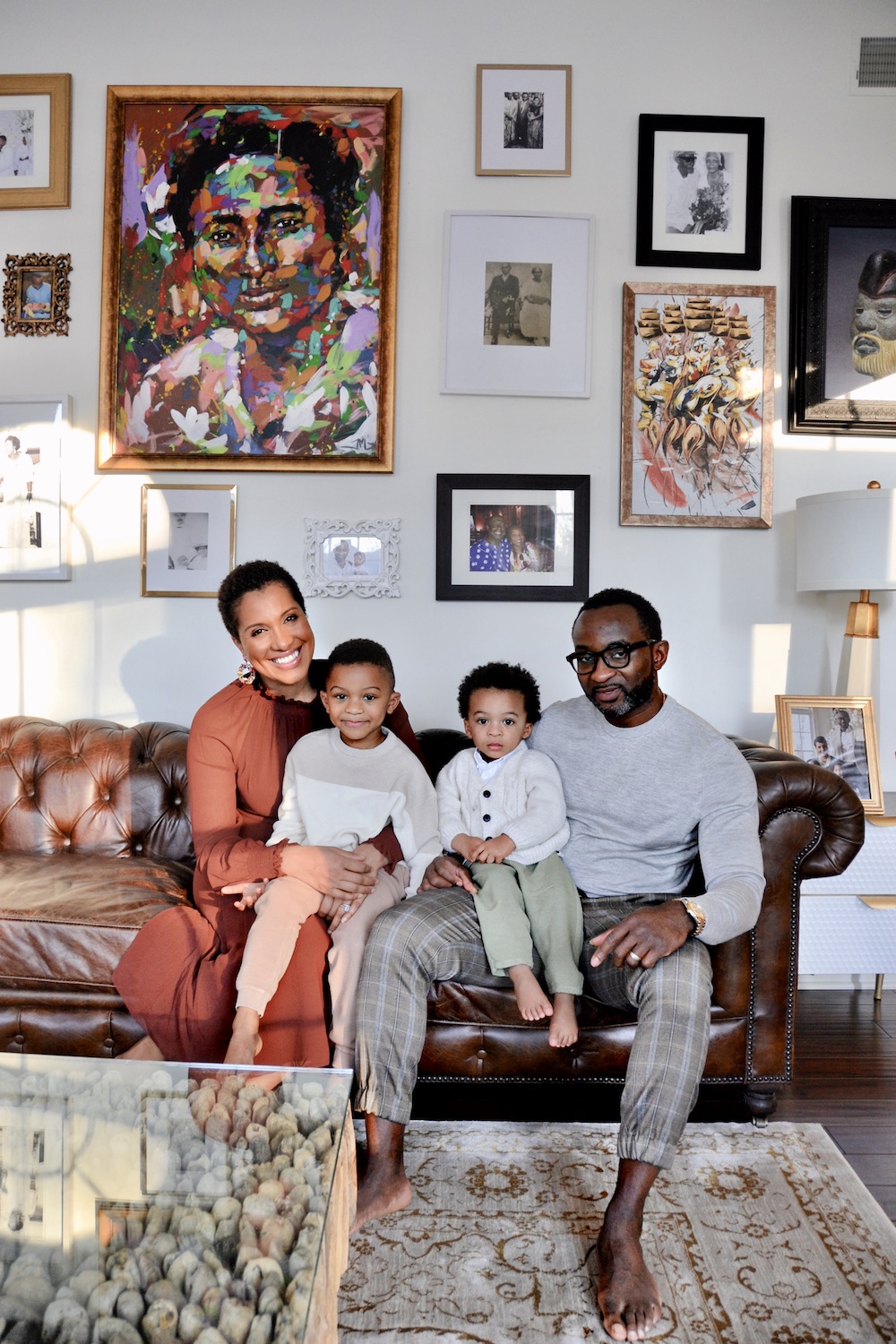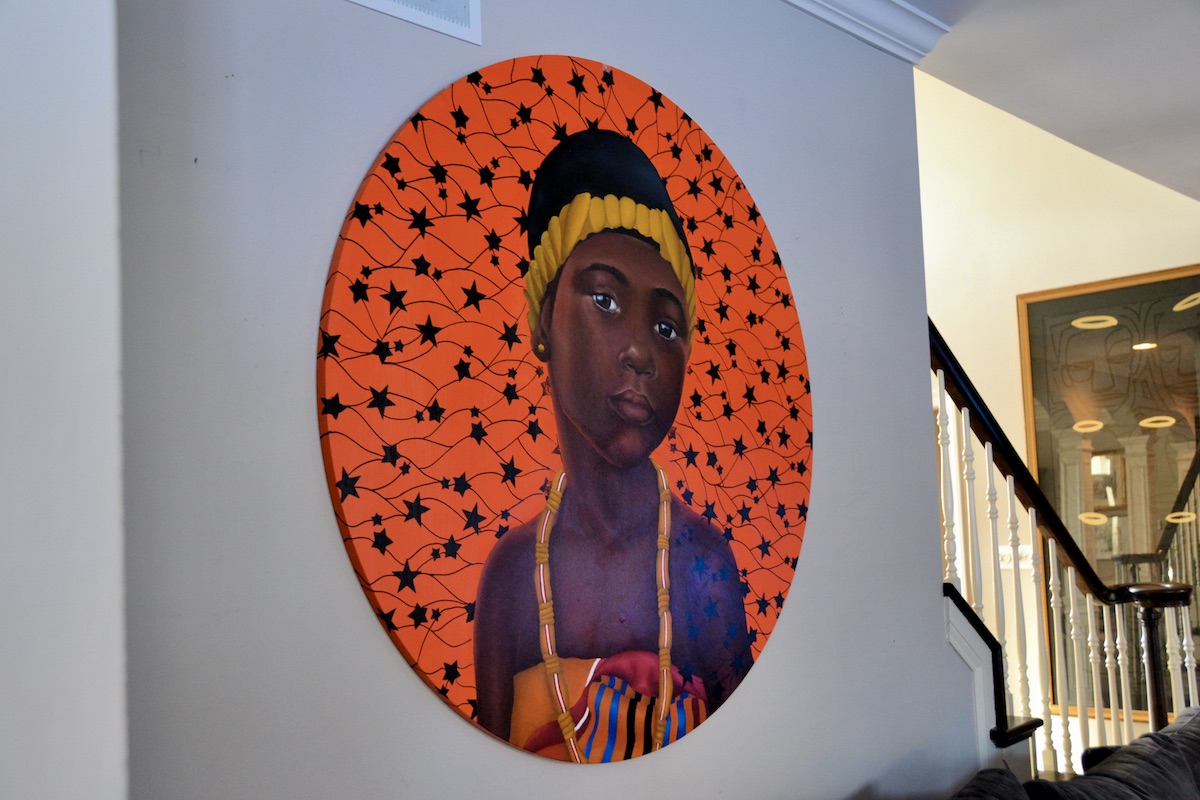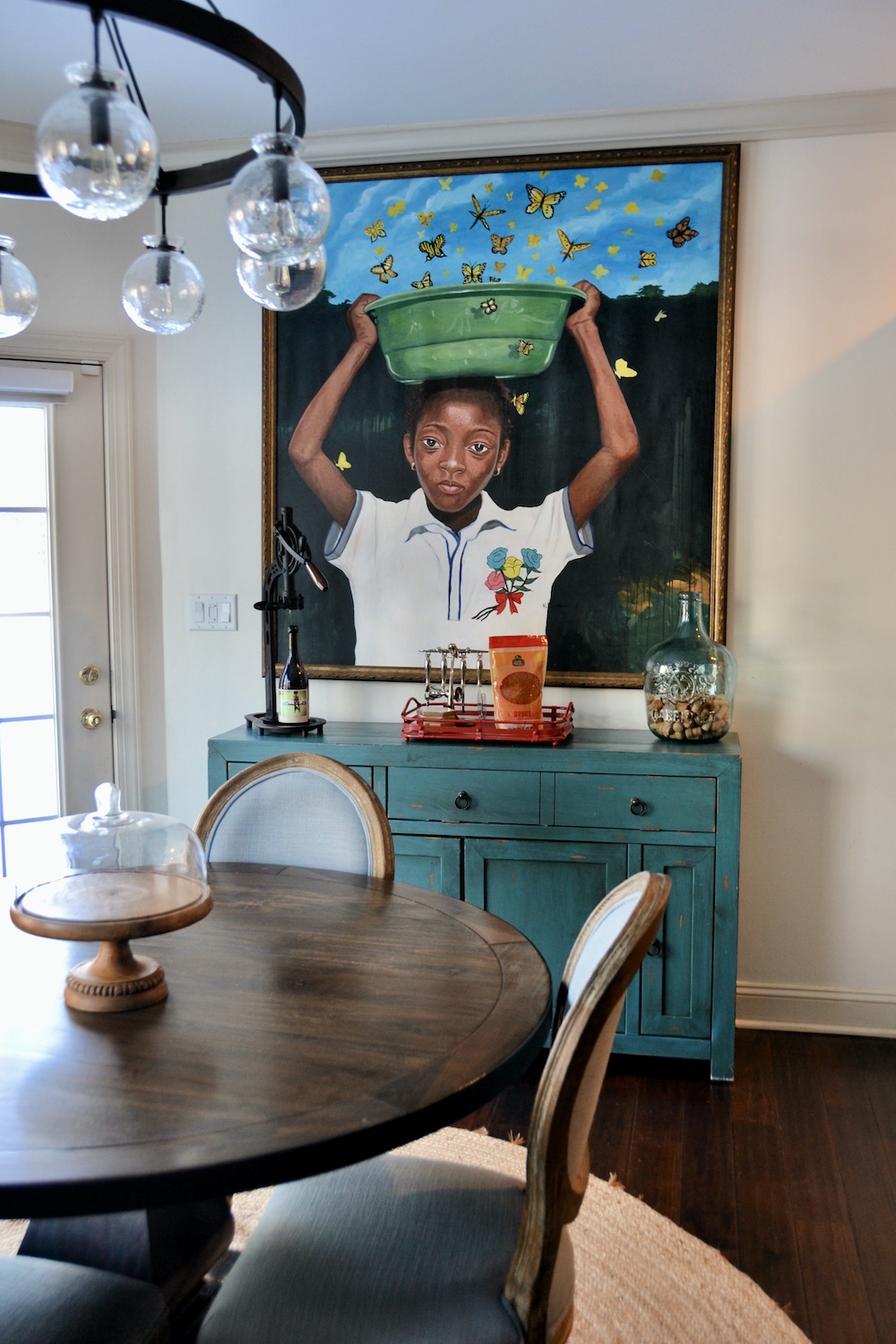Having grown up in Anguilla and Ghana respectively, Drs. Tonya and Ato Wright are attracted to artistic stories that reflect their own journeys and growth experiences in the US while navigating a life in America with two sons. That explains the thread in their art collection being artists of the African diaspora. While Tonya is an Obstetrician Gynecologist and Ato is a Radiation Oncologist, they are drawn to rather figurative depictions. “Telling stories of our art in the context of our home” is the tagline of their Instagram profile filled with arty home interiors. That caught our attention, and they are listed in the Next Gen Art Collectors report published in February 2021.
The collector couple discussed with LARRY’S LIST how they foster an environment of creativity and excellence for their two sons through art; what kind of artworks best represent their individual journeys and their forever partnership and marriage; what artists they have discovered through Instagram; and the art event they look forward to the most in 2021.

Collecting
What made you want to start collecting art? What is the main motivation behind your collecting?
Initially we were inspired by other amazing art collectors, but ultimately we wanted to create our own beautiful living space where we showcased positive and uplifting imagery of individuals that resemble us and tell stories about the black experience. A key motivation for us and our collection is our two sons. We aim to foster an environment of creativity and excellence where both the art and the artist serve as examples of this.
When did you fall in love with a piece of art? What was it?
In September of 2020, we decided to commission an image of Kamala Harris (the then Democratic Vice-Presidential nominee for the US election). The significance of her breaking new ground and being the first woman of color to be nominated in the role was not lost on us. We made arrangements for it to be transported from the Chicago-based artist, Roger J Carter, to our home in Pennsylvania but never imagined that it would arrive on the very same day and within the very hour that her victory was announced. When the piece was unveiled – a mixed media, 7×5-foot canvas bearing her silhouette in acrylic paint, on a brilliant blue backdrop and with toy soldiers and action figures uniquely pasted over the image – we were astounded. We commissioned this with the hope of capturing a monumental event in the history of our lifetime, but the manner in which it manifested superseded our expectations. When art collides with life in such a beautiful way, it is a moment that we will cherish forever.

What is your focus regarding the artists in your collection? And why?
We collect art from all over the world with a focus on artists of the African diaspora. We like artists who have a unique approach to storytelling. Having grown up in Ghana (Ato) and Anguilla (Tonya), and now navigating a life in America with two sons, we are attracted to artistic stories that reflect our own journeys and our growth experiences here in the US.

We see many images of portrait or figurative paintings on your Instagram profile. Is it the theme that unites all the works you have collected?
That may be the case, but it is certainly not intentional for it to be strictly figurative. But the intention is in the imagery – the strong depictions of stories and figures that resonate with us and also help push the culture forward. We like to call these images…images of affirmation.
How is your collecting related to your medical professions? How does your profession influence your perceptions or tastes for art?
As a Radiation Oncologist (Ato) and an Obstetrician Gynecologist (Tonya) with a demanding vocation centered on caring for others, it is important for us to come home to a place of solace for some calm and relaxation.
Perhaps our journeys thus far have drawn us to more figurative depictions as opposed to abstract, because of our very structured and scientific subconscious.

What were the first and the latest artworks you purchased?
Our first piece, “Grandma Maud” was a commission by artist Jon Moody of New Orleans. It was with the acquisition of this piece that we started to imagine art as a part of our life’s story and not just a decoration on the wall. Art… as a means of telling stories about the past, and capturing today’s historic moments.
Our most recent piece is called “Revered” by artist Gordon Shadrach of Toronto, and this piece certainly led us down a path to new lessons — lessons regarding a very important piece of American history about the Black Loyalists.

How many artworks do you own? Where do you display your collection?
Roughly 70 pieces, displayed all throughout our home.
Have you ever presented/ Would you wish to present your art collection publicly?
We have not presented publicly but would consider it if the opportunity arises.

What is your most treasured artwork?
They all are. We wouldn’t designate any as “most treasured” necessarily, but perhaps if there are any pieces that resonate with our idea of what things we treasure most, it would be Lindele Msweli’s pair called Uhambo and Uhambo II. Translated from his native South African Xhosa language to mean “The Journey”. To us, they represent our individual journeys, along our respective paths that ultimately led us together in this forever partnership and marriage.
How important is it for you to meet the artists who created the artwork?
It is very important for us to have a connection with the artist. Thanks to technology, we are now able to connect with artists through media, such as direct messaging on social media, texting, and even FaceTime. We learn a lot about people and cultures by listening to artists from around the world talk about their art and creative process.

You opened an Instagram account dedicated to your collection few months ago. What made you want to do that? How do you make use of Instagram for collecting?
Over the years we have had friends and family express an appreciation for our art and a desire to start their own collections. However, they have found the process to be somewhat intimidating. The purpose of the Instagram account was to inspire friends and family to start their own collections and to normalize living with powerful art, rather than the concept of art existing only in galleries and museums.
Instagram has really opened up the access to art for us as well. Through Instagram we have been able to connect with brilliant artists, like Alanis Forde in Barbados, whose work features expressionistic realism portraiture set on exotic, Caribbean landscapes and collage; Alex Peter Idoko, whose use of flame and razorblade on board creates a masterful and unique pyrograph; and Thokazani Mandosela, who creates joyful, happy-go-lucky figures meant to depict neutrality in the human identity.

“Telling stories of our art in the context of our home,” as you put in the bio on Instagram, what do you consider when choosing artworks for your home?
We choose works that are going to provoke thought and help answer questions. When considering pieces and the placement within our living space, we think about the cohesive stories each piece tells within the context of the room. For example, our formal living room, or “legacy room” as we call it, is filled with pieces that have a historic context, both personally and generally. A portrait of Ato’s grandmother “Grandma Maud” lives here amongst others by Kajahl, Lindel Msweli, and Gordon Shadrach.

The Art World
What was your happiest moment being involved in art?
Living with art provides many moments of happiness. One image that exemplifies that as a recurring theme in our lives and household is the piece by Kwesi Botchway called “Lucky Delivery”. Being able to sit down and have a meal in the presence of this image invokes a daily sense of gratitude for this happiness that we live in.

Who inspires you the most in the art world?
We are inspired most by a collective of art lovers with whom we have formed a fast fellowship in the name of art. This group started with a few guys, Chris Craft, Bryant Bowens, and Reginald Brown, all of whom have amazing collections, and has since grown into a larger collective of curators, art advisors, gallerists, artists and so forth. I am sure this group will continue to shape my approach to collecting. Additionally, with the platform we have built and continue to build, I envision a continued influence that will help inspire more people to collect. For Black art to exist, it requires spaces and communities that foster it. We are proud to be part of this community that patronizes and promotes the growth of black artists at various career levels.

Can you name three emerging artists of African origin we should watch out for?
Kojo Marfo, Luke Agada, and Richard Atugonza.
What are you especially excited about in regard to art in 2021?
We are looking forward to attending “Prospect” New Orleans, October, 2021. This is the 5th iteration of this citywide art event that occurs every 3 years and hosts artists from around the world. Its purpose is to invite visitors and residents to experience the city through the eyes of an artist. Not only is New Orleans a place rich in culture, diversity, and history, it continues to be a very special place for us as the origin of our first piece of art, the birthplace of our first son and the home to many of our loved ones.

Instagram: @thewrightartcollection
A selection of artists Tonya and Ato collect:
Alanis Forde
Alex Peter Idoko
Gordon Shadrach
Lindele Msweli
Roger J Carter
By Ricko Leung





